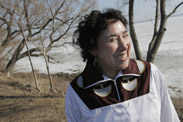In focus
David Krawitz: Writing blocks
Just as any structure would collapse without a sturdy foundation, so the McGill School of Architecture requires a solid groundwork to maintain its successful day-to-day functioning. Among its pillars is David Krawitz, the school's administrative officer. Yet working among architects and soon-to-be architects was not always a part of his design.

The administrative officer in the School of Architecture, David Krawitz
Owen Egan
Krawitz's previous experience in architecture is essentially non-existent. Originally from Winnipeg, he graduated from the University of Toronto with a BA in English and classics. Like many graduates, he left university unsure of where he was heading. He found a niche as researcher and editor for Professor Avi Friedman in the Affordable Homes Program. Krawitz spent the next seven years sitting in a dark basement cubbyhole in front of a computer screen working at a highly autonomous job.
The result of this work was a series of academic journals co-authored with Friedman. But perhaps the most notable product of his days as scribe is Krawitz's first published book, co-authored with Friedman, Peeking Through the Keyhole: The Evolution of North American Homes.
The book examines the way in which society has changed since the Second World War and how this change is reflected in the way we use and live in our homes. It does not adopt a technical viewpoint. Krawitz said, "‘Home' evokes a concept that goes beyond the building itself and its design. It implies the use of the building and the people who live in it."
Many of the conclusions drawn by the authors are, in fact, evidenced in Krawitz's own home in Montreal's Plateau district -- a neighborhood typified by its compact yet highly convenient houses. "What we wanted to suggest was that if someone grew up in a large house and ended up living in a smaller house with a smaller family, it's not because somehow they've come down in the world: it's simply that they've adapted to changes in the way that society has evolved over the past 60 years," he said.
But Krawitz's days of authoring journals and publishing books are now long behind him. In fact, he considers his years as editor, writer and researcher his "previous life in the building." If his first seven years working within the confines of the Macdonald-Harrington Building seem rather reclusive, his last four years have been vibrant and active.
Today Krawitz is the McGill School of Architecture's backbone: assisting the director, providing administrative support, maintaining relations with alumni and other architectural establishments, editing texts, updating the school's website and coordinating exhibitions and events are but a few of his responsibilities.
Krawitz seems to indeed relish his current dynamic role within the school. Meeting and communicating with an endless variety of people has provided a dramatic contrast to his earlier tasks.
He has greatly enjoyed his increasingly close relationship with the students. "The whole university, in the end, is about the students," said Krawitz. "The better you accommodate yourself to them, the easier and more satisfying and gratifying your job." He remarked, with a hint of nostalgia, that the class he started with will be graduating next year. "I feel like we're graduating together."
In many ways, Krawitz is the odd man on campus in the School of Architecture. Yet he values his status in the school as a non-architect because it has allowed him to maintain a certain form of distance, providing balance. "I am not walking around with an architect's sensibility," Krawitz acknowledges. "The life of fiction and poetry is more significant to me than architecture."
Aboriginal instructor looks out for others

Lolly Annahatak
Owen Egan
Lolly Annahatak may be visually impaired, but that hasn't stopped her from looking out for others as a social worker.
Call it fate, but in her native language of Inuktitut, "Annahatak" translates into "one who provides for the survival of others."
"We need to help one another," says Annahatak, who's counseled and provided so well for those in Quebec's Kuujjuaq region that she's been recognized with National Aboriginal Achievement Award (NAAA). She was among 14 Aboriginal leaders to obtain the distinction last month.
"I find it quite astonishing that someone from a small, isolated place could be honored this way," she says.
Annahatak, who lost her sight at 16, grew up in Kangirsuk in Northern Quebec: population 394. Her initial contact with McGill and the big city came in the mid-80s -- when she became the first Inuk to complete a certificate course in Northern Social Work Practice.
In a bid for more knowledge, Annahatak uprooted herself and family to Montreal to complete an undergraduate degree at McGill's School of Social Work. The move was a sacrifice undertaken with husband Peter, daughter Phebe and son Danielli. Father and kids headed back north after a year. Annahatak stayed in Montreal.
"I wanted to finish my degree," she recalls, "but I was quite sad being alone in Montreal."
Yet sadness turned to pride when she graduated in 1997 and became the first native social worker in Kuujjuaq. Today, Annahatak retains links with McGill as a translator and instructor for the University's Certificate Program in Northern Social Work Practice. Offered through the Centre for Continuing Education, the program continues to prepare Inuit community workers to practice social work within their communities.
Annahatak has broken many barriers among disabled Aboriginals: she was the first student guidance counselor at the Kativik School Board to earn a certificate in Northern social work; she served as a member of the Inuit Justice Task Force and has worked for Quebec government's Aboriginal First Nation Suicidal Prevention Committee.
She continues to visit many Northern communities for the Nunavik Health Board to conduct research on the needs for the disabled. Annahatak also works as a social worker at the Tulattavik Hospital and a team leader in social assistance fieldwork for the Ungava region.
"I'm very proud of myself," she says of her accomplishments. Annahatak is only sorry that her husband died last year - before she received her National Aboriginal Achievement Award.
"Peter would have been proud of this award, too."
